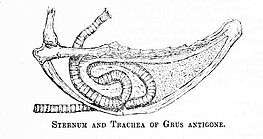Grus (genus)
| Grus | |
|---|---|
 | |
| Sarus crane, Grus antigone | |
| Scientific classification | |
| Kingdom: | Animalia |
| Phylum: | Chordata |
| Class: | Aves |
| Order: | Gruiformes |
| Suborder: | Grui |
| Family: | Gruidae |
| Genus: | Grus Brisson, 1760 |
| Species | |
|
10, see text | |

Grus is a genus of large birds in the crane family. The genus name is from Latin; grus, "crane". Grus was first applied to the grey-winged trumpeter, but this was overlooked for many years so it was retained for the cranes as a nomen conservandum.[1]
Species
- Siberian crane, Grus leucogeranus
- Sandhill crane, Grus canadensis
- Lesser sandhill crane or little brown crane, Grus (canadensis) canadensis
- Greater sandhill crane, Grus (canadensis) pratensis
- White-naped crane, Grus vipio
- Sarus crane, Grus antigone
- Brolga, Grus rubicunda
- Demoiselle crane, Grus virgo
- Blue crane, Grus paradisea
- Wattled crane, Grus carunculata
- Red-crowned crane, Grus japonensis
- Whooping crane, Grus americana
- Common crane, Grus grus
- Hooded crane, Grus monacha
- Black-necked crane, Grus nigricollis
The HBW/BirdLife and Clements checklists split this genus into five, with the Siberian crane in the monospecific genus Leucogeranus; the sandhill crane, white-naped crane, sarus crane, and brolga in the genus Antigone; the demoiselle crane and blue crane in the genus Anthropoides; and the wattled crane in the monospecific genus Bugeranus, leaving only the red-crowned, whooping, common, hooded, and black-necked cranes in the genus Grus.
The Cuban flightless crane, Grus cubensis, became extinct in the Quaternary, but probably before human settlement of Cuba.
Fossil record
The fossil record of the genus stretches back some 12 million years or so. A considerable number of prehistoric species are known, with the oldest, Grus miocaenicus (Middle Miocene of Credinţa, Romania) perhaps not a crane but a junior synonym of the swimming-flamingo Palaelodus ambiguus; ("Grus" problematica certainly is). The Late Pleistocene Mediterranean Grus primigenia was hunted by stone age humans.
- Grus afghana (Late Miocene of Molayan, Afghanistan) - doubtfully distinct from G. penteleci
- Grus sp. 1 (Late Miocene of Love Bone Bed, USA)
- Grus sp. 2 (Late Miocene of Love Bone Bed, USA)
- Grus cf. antigone (Late Miocene/Early Pliocene of Lee Creek Mine, USA)
- Grus nannodes (Late Miocene/Early Pliocene -? Edson Middle Pliocene of Sherman County, USA)
- Grus sp. (Late Miocene/Early Pliocene of Lee Creek Mine, USA)
- Grus haydeni (Late Miocene/Early Pliocene - Pleistocene? of WC USA) - 2 species, one may be same as G. canadensis
- Grus penteleci (Late Miocene - Early Pliocene of C and SE Europe) - formerly in Pliogrus
- Grus sp. (Late Pliocene of Puebla de Valverde, Spain)
- Grus bogatshevi (Late Pleistocene of Azerbaijan) - doubtfully distinct form G. primigenia
- Grus latipes (Shore Hills Late Pleistocene of Bermuda, W Atlantic) - formerly Baeopteryx
- Maltese crane Grus melitensis (Late Pleistocene of Malta) - doubtfully distinct from G. primigenia
- Grus pagei (Late Pleistocene of Rancho La Brea)
- Grus primigenia (Late Pleistocene? of SW Europe)
Several other fossil gruiforms are now considered not to belong here. "Grus" prentici is now in Paragrus, "Grus" princeps, "Grus" excelsa and "Grus" hordwellianus are placed in Palaeogrus, and "Grus" excelsa in Balearica. "Grus" marshi belongs into Aletornis
More uncertain is the position of Probalearica (variously considered Late Oligocene to Middle Pliocene but probably Late Miocene) from Golboçica (Moldavia) and maybe elsewhere. It is usually regarded a nomen dubium but might belong into Grus. "Grus" conferta (Late Miocene/Early Pliocene of Contra Costa County, USA) is apparently too different from the modern genus to be placed herein, but its affiliations are not well resolved.